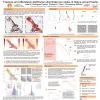Poster #132, Fault and Rupture Mechanics (FARM)
Creating a multi-proxy approach to robustly capture earthquake temperature rise at the Punchbowl fault
Poster Image:

Poster Presentation
2020 SCEC Annual Meeting, Poster #132, SCEC Contribution #10480 VIEW PDF
for this inter-method comparison. Apatite and zircon are accessory minerals present in most rock types and low-temperature thermochronometry, including the zircon (U-Th)/He and apatite fission-track systems, are sensitive to (He loss, track annealing) short duration, high temperatures. Radiation-damaged, or metamict, zircon is more susceptible to He loss from frictional heating than pristine zircon.
Initial sampling involved reoccupying two sites of Savage and Polissar (2019) and one new site. We collected 14 samples in fault-perpendicular transects including crystalline basement, black ultracataclasite derived from basement, PSZ fault gouge, brown ultracataclasite derived from the Punchbowl formation, and Punchbowl formation. These domains were readily distinguished by color and competency, and carefully extracted to avoid cross-contamination. Basement was slabbed parallel to the PSZ orientation at 1-cm-intervals away from the basement/black ultracataclasite contact. Mineral separation yields apatite fragments and whole zircon crystals amenable to fission track and (U-Th)/He analysis, respectively, in all domains including the highly damaged PSZ. Zircon grains in each sample exhibit a range of visual metamictization. Assuming some domains experienced temperatures up to 1000 °C consistent with biomarker data, this implies radiation damage persists through coseismic heating and can be used to identify grains most amenable to thermal resetting. Thermochronometry data patterns may include shortened track lengths and younger dates with increasing proximity to the PSZ. Our multi-proxy approach will overcome limitations of individual methods to more robustly capture past temperature rise that can be used to calculate frictional energy and the magnitude of past earthquakes.
SHOW MORE
Initial sampling involved reoccupying two sites of Savage and Polissar (2019) and one new site. We collected 14 samples in fault-perpendicular transects including crystalline basement, black ultracataclasite derived from basement, PSZ fault gouge, brown ultracataclasite derived from the Punchbowl formation, and Punchbowl formation. These domains were readily distinguished by color and competency, and carefully extracted to avoid cross-contamination. Basement was slabbed parallel to the PSZ orientation at 1-cm-intervals away from the basement/black ultracataclasite contact. Mineral separation yields apatite fragments and whole zircon crystals amenable to fission track and (U-Th)/He analysis, respectively, in all domains including the highly damaged PSZ. Zircon grains in each sample exhibit a range of visual metamictization. Assuming some domains experienced temperatures up to 1000 °C consistent with biomarker data, this implies radiation damage persists through coseismic heating and can be used to identify grains most amenable to thermal resetting. Thermochronometry data patterns may include shortened track lengths and younger dates with increasing proximity to the PSZ. Our multi-proxy approach will overcome limitations of individual methods to more robustly capture past temperature rise that can be used to calculate frictional energy and the magnitude of past earthquakes.
SHOW MORE


























































